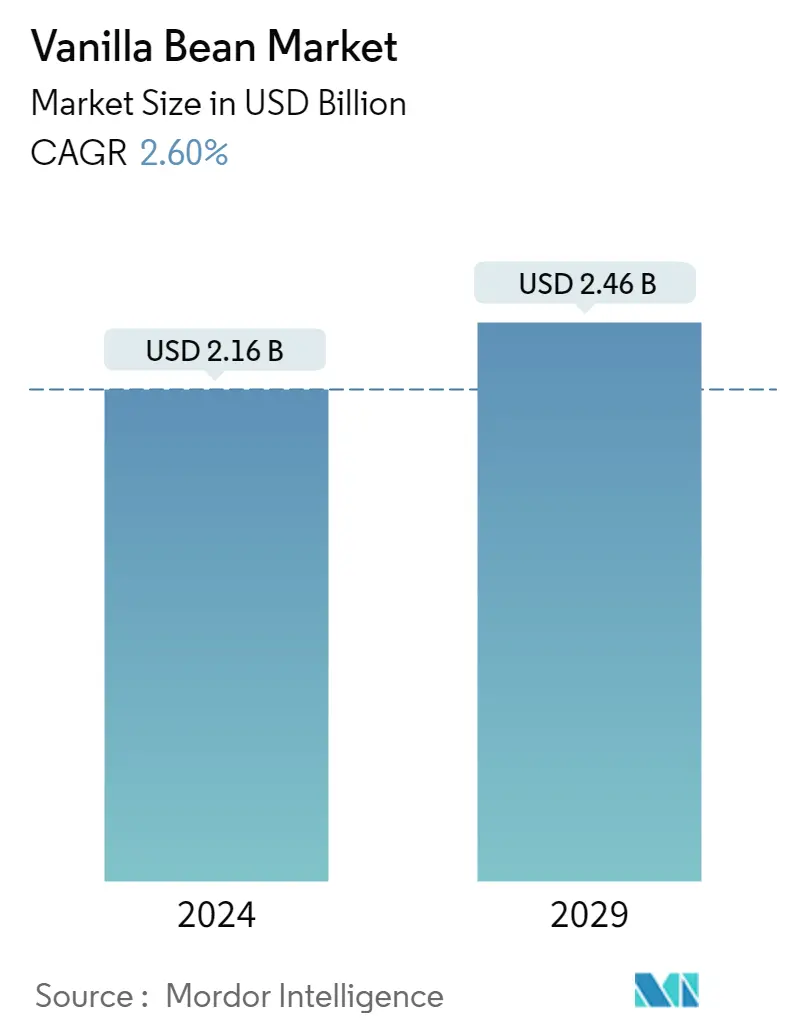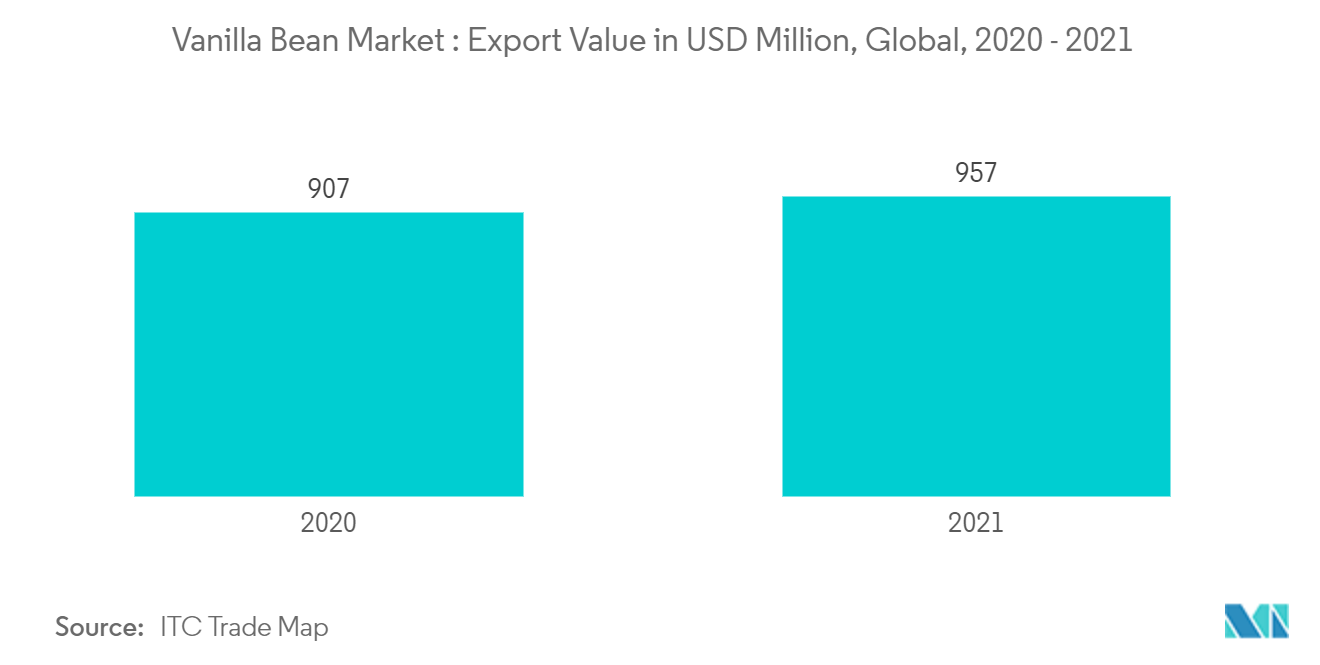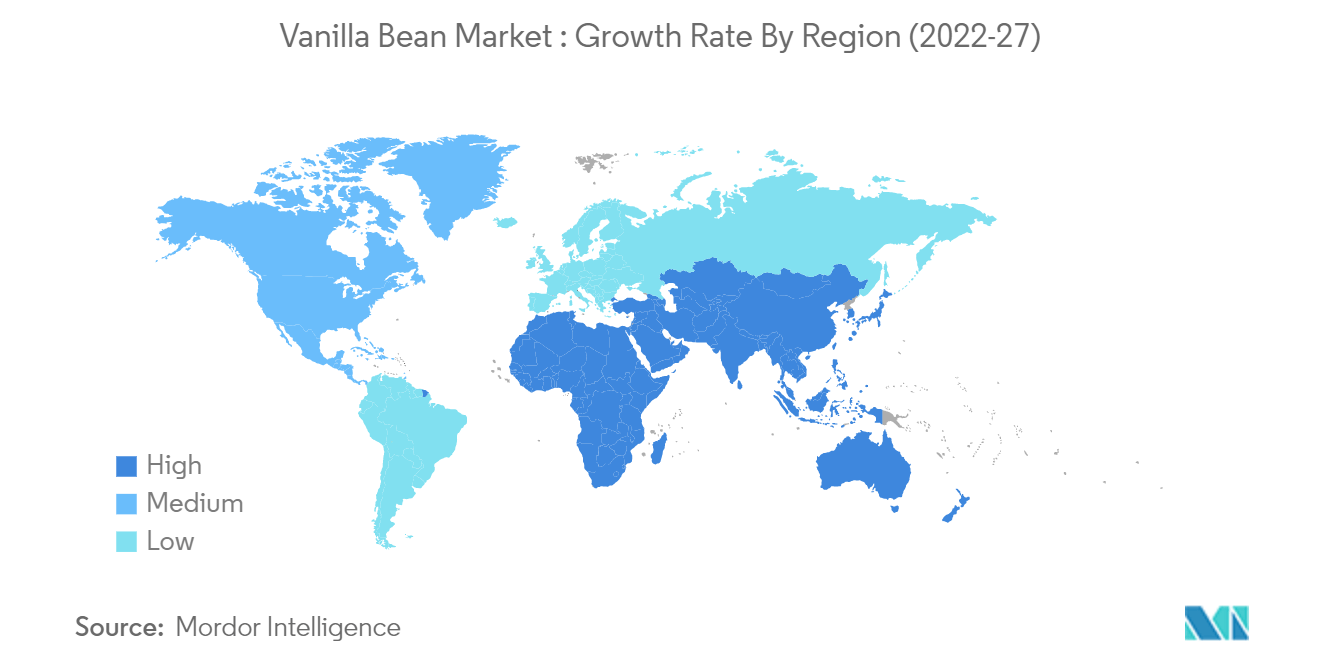Vanilla Bean Market Size

| Study Period | 2019 - 2029 |
| Market Size (2024) | USD 2.16 Billion |
| Market Size (2029) | USD 2.46 Billion |
| CAGR (2024 - 2029) | 2.60 % |
| Fastest Growing Market | North America |
| Largest Market | Africa |
Major Players*Disclaimer: Major Players sorted in no particular order |
Vanilla Bean Market Analysis
The Vanilla Bean Market size is estimated at USD 2.16 billion in 2024, and is expected to reach USD 2.46 billion by 2029, growing at a CAGR of 2.60% during the forecast period (2024-2029).
Vanilla is majorly produced in countries like Madagascar, Indonesia, Mexico, and China. The United States, France, and Germany are the major importer of vanilla. Madagascar accounts for over half of the world's vanilla output and contributed more than half of the world's export value in 2021. Although Madagascar retains the gold standard for vanilla quality, Indonesia is rising to the potential to become a viable alternative origin in terms of both quantity and quality. Due to increased vanilla demand by the super-premium ice cream business, vanilla exports from Madagascar, Indonesia, and other producing nations are expanding, mainly to Europe and the United States.
Vanilla beans are widely used in the food and beverage, cosmetics, and pharmaceutical industries due to their antioxidant and anti-carcinogenic properties. North America has experienced a rise in demand for vanilla-flavored food, ice creams, cosmetics, and pharmaceuticals, driving the vanilla bean market. The increasing population and demand for flavored food and beverages have been increasing, eventually driving market growth.
Vanilla Bean Market Trends
This section covers the major market trends shaping the Vanilla Bean Market according to our research experts:
Application in Food and Pharmaceutical Industry is Driving the Market
The majority of vanilla produced is traded as a commodity (generic product) in vanilla beans. Vanilla product buyers are divided into home and industrial consumers with unique purchasing habits. Household users often buy finished vanilla goods like vanilla beans, extracts, or pasta at retail. In contrast, businesses typically buy vanilla as an ingredient in the form of vanilla beans in large quantities. Thus, industrial customers are more inclined to acquire vanilla beans as a commodity, but domestic consumers are more likely to purchase end goods (certified or branded).
Vanilla is widely used in the food and beverage industry as a flavoring ingredient in jellies, jams, and syrups. The antioxidants and antibacterial properties of vanilla make it suitable for skin cleansing and treating damaged skin-related problems. It is also known to alleviate anxiety disorders and depression. These benefits associated with the consumption of vanilla are expected to boost consumers' demand.
Vanilla possesses antioxidant properties and anti-carcinogenic properties, due to which it is widely used in the pharmaceutical industry. Vanillin, a flavorful constituent of vanilla pods, is used as a flavonoid in foods and beverages, pharmaceuticals, and cosmetics. The demand for vanilla is increasing in the pharmaceutical industry due to its antioxidant and anti-carcinogenic properties. As a result, the vanilla bean market is projected to grow during the forecast period. Due to these factors, demand for vanilla is increasing around the globe, thus impacting the vanilla bean trade positively.

Africa Dominates the Vanilla Beans Market
As vanilla production is highly labor-intensive, countries with low labor costs are favored. According to FAO, in 2020, Madagascar produced 2975 metric tons of vanilla. Countries with low growth rates are expected to have a long-term labor cost advantage within the vanilla market, leading to increased production and rankings.
Madagascar remains a top producer of vanilla worldwide because of its major advantage over the labor force component in the agricultural sector. Uganda produced 185 tons of vanilla in 2020. Comoros is also expected to be a major producer of vanilla in the African region. It is estimated that at least 70% of the working population in Comoros's rural areas is involved in vanilla production.
Several farmers in central and western Uganda are receiving vanilla farming assistance owing to the intervention of multinational conglomerates. Tanzanian farmers prefer vanilla over coffee for higher profits. According to Tanzania's Agriculture Ministry, vanilla production has increased significantly in the last five years, rising from 229.8 ton per year in 2015 to 1,949 ton in 2020. Smallholder farmers in Tanzania are generating revenues from the surging global vanilla market, which is helping them in balancing losses caused by weak yields from conventional cash crops, including coffee.

Vanilla Bean Market News
- June 2022: As of June 2022, around 25,000 hectares of land in Madagascar is dedicated to vanilla cultivation, engaging as many as 80,000 farmers. The majority of the world's finest beans come from the northeastern Sava region. Madagascan vanilla is mainly used in the chocolates, cakes, and ice creams sold to consumers around the globe.
- September 2022: Vanilla Vida, an Israeli start-up company, is transforming vanilla production using image processing technology and various non-GMO methods to alter the metabolism of vanilla beans. This method increases flavor levels and ensures the right balance and profile of the vanilla flavor.
- January 2020: Nielsen-Massey Vanillas introduced 2-oz. bottles of its Madagascar Bourbon Pure Vanilla Bean Paste and Pure Vanilla Bean Paste at the 2020 Winter Fancy Food Show in San Francisco. The company claimed that the product is crafted from the brand's famous pure, premium vanilla extracts and infused with real vanilla bean specks. It announced that paste is also available in 4-oz., 32-oz., and gallon sizes.
Vanilla Bean Market Report - Table of Contents
1. INTRODUCTION
- 1.1 Study Assumptions and Market definition
- 1.2 Scope of the Study
2. RESEARCH METHODOLOGY
3. EXECUTIVE SUMMARY
4. MARKET DYNAMICS
- 4.1 Market Overview
- 4.2 Market Drivers
- 4.3 Market Restraints
- 4.4 Value Chain Analysis
5. MARKET SEGMENTATION
-
5.1 Geography
- 5.1.1 United States
- 5.1.1.1 Production Analysis
- 5.1.1.2 Consumption Analysis and Market Value
- 5.1.1.3 Import Market Analysis (Value and Volume)
- 5.1.1.4 Export Market Analysis (Value and Volume)
- 5.1.1.5 Price Trend Analysis
- 5.1.2 Canada
- 5.1.2.1 Production Analysis
- 5.1.2.2 Consumption Analysis and Market Value
- 5.1.2.3 Import Market Analysis (Value and Volume)
- 5.1.2.4 Export Market Analysis (Value and Volume)
- 5.1.2.5 Price Trend Analysis
- 5.1.3 Mexico
- 5.1.3.1 Production Analysis
- 5.1.3.2 Consumption Analysis and Market Value
- 5.1.3.3 Import Market Analysis (Value and Volume)
- 5.1.3.4 Export Market Analysis (Value and Volume)
- 5.1.3.5 Price Trend Analysis
- 5.1.4 Germany
- 5.1.4.1 Production Analysis
- 5.1.4.2 Consumption Analysis and Market Value
- 5.1.4.3 Import Market Analysis (Value and Volume)
- 5.1.4.4 Export Market Analysis (Value and Volume)
- 5.1.4.5 Price Trend Analysis
- 5.1.5 France
- 5.1.5.1 Production Analysis
- 5.1.5.2 Consumption Analysis and Market Value
- 5.1.5.3 Import Market Analysis (Value and Volume)
- 5.1.5.4 Export Market Analysis (Value and Volume)
- 5.1.5.5 Price Trend Analysis
- 5.1.6 Netherlands
- 5.1.6.1 Production Analysis
- 5.1.6.2 Consumption Analysis and Market Value
- 5.1.6.3 Import Market Analysis (Value and Volume)
- 5.1.6.4 Export Market Analysis (Value and Volume)
- 5.1.6.5 Price Trend Analysis
- 5.1.7 Japan
- 5.1.7.1 Production Analysis
- 5.1.7.2 Consumption Analysis and Market Value
- 5.1.7.3 Import Market Analysis (Value and Volume)
- 5.1.7.4 Export Market Analysis (Value and Volume)
- 5.1.7.5 Price Trend Analysis
- 5.1.8 Indonesia
- 5.1.8.1 Production Analysis
- 5.1.8.2 Consumption Analysis and Market Value
- 5.1.8.3 Import Market Analysis (Value and Volume)
- 5.1.8.4 Export Market Analysis (Value and Volume)
- 5.1.8.5 Price Trend Analysis
- 5.1.9 China
- 5.1.9.1 Production Analysis
- 5.1.9.2 Consumption Analysis and Market Value
- 5.1.9.3 Import Market Analysis (Value and Volume)
- 5.1.9.4 Export Market Analysis (Value and Volume)
- 5.1.9.5 Price Trend Analysis
- 5.1.10 Madagascar
- 5.1.10.1 Production Analysis
- 5.1.10.2 Consumption Analysis and Market Value
- 5.1.10.3 Import Market Analysis (Value and Volume)
- 5.1.10.4 Export Market Analysis (Value and Volume)
- 5.1.10.5 Price Trend Analysis
- 5.1.11 Papua New Guinea
- 5.1.11.1 Production Analysis
- 5.1.11.2 Consumption Analysis and Market Value
- 5.1.11.3 Import Market Analysis (Value and Volume)
- 5.1.11.4 Export Market Analysis (Value and Volume)
- 5.1.12 Uganda
- 5.1.12.1 Production Analysis
- 5.1.12.2 Consumption Analysis and Market Value
- 5.1.12.3 Import Market Analysis (Value and Volume)
- 5.1.12.4 Export Market Analysis (Value and Volume)
- 5.1.12.5 Price Trend Analysis
6. MARKET OPPORTUNITIES AND FUTURE TRENDS
** Subject To AvailablityVanilla Bean Industry Segmentation
Vanilla bean is the fruit of an orchid plant, which grows in the form of a dark brown bean pod that is long and skinny. The Vanilla bean market is segmented based on geography (United States, Canada, Mexico, Germany, France, Netherlands, Japan, Indonesia, China, Madagascar, Papua New Guinea, and Uganda). The report contains an analysis of various parameters of the vanilla bean market globally. The report includes Production (Volume), Consumption (Value and Volume), import (Value and Volume), export (Value and Volume), and price trend analysis of vanilla beans. The report offers market size and forecasts in terms of value (USD million) and volume (metric ton).
| Geography | United States | Production Analysis |
| Consumption Analysis and Market Value | ||
| Import Market Analysis (Value and Volume) | ||
| Export Market Analysis (Value and Volume) | ||
| Price Trend Analysis | ||
| Geography | Canada | Production Analysis |
| Consumption Analysis and Market Value | ||
| Import Market Analysis (Value and Volume) | ||
| Export Market Analysis (Value and Volume) | ||
| Price Trend Analysis | ||
| Geography | Mexico | Production Analysis |
| Consumption Analysis and Market Value | ||
| Import Market Analysis (Value and Volume) | ||
| Export Market Analysis (Value and Volume) | ||
| Price Trend Analysis | ||
| Geography | Germany | Production Analysis |
| Consumption Analysis and Market Value | ||
| Import Market Analysis (Value and Volume) | ||
| Export Market Analysis (Value and Volume) | ||
| Price Trend Analysis | ||
| Geography | France | Production Analysis |
| Consumption Analysis and Market Value | ||
| Import Market Analysis (Value and Volume) | ||
| Export Market Analysis (Value and Volume) | ||
| Price Trend Analysis | ||
| Geography | Netherlands | Production Analysis |
| Consumption Analysis and Market Value | ||
| Import Market Analysis (Value and Volume) | ||
| Export Market Analysis (Value and Volume) | ||
| Price Trend Analysis | ||
| Geography | Japan | Production Analysis |
| Consumption Analysis and Market Value | ||
| Import Market Analysis (Value and Volume) | ||
| Export Market Analysis (Value and Volume) | ||
| Price Trend Analysis | ||
| Geography | Indonesia | Production Analysis |
| Consumption Analysis and Market Value | ||
| Import Market Analysis (Value and Volume) | ||
| Export Market Analysis (Value and Volume) | ||
| Price Trend Analysis | ||
| Geography | China | Production Analysis |
| Consumption Analysis and Market Value | ||
| Import Market Analysis (Value and Volume) | ||
| Export Market Analysis (Value and Volume) | ||
| Price Trend Analysis | ||
| Geography | Madagascar | Production Analysis |
| Consumption Analysis and Market Value | ||
| Import Market Analysis (Value and Volume) | ||
| Export Market Analysis (Value and Volume) | ||
| Price Trend Analysis | ||
| Geography | Papua New Guinea | Production Analysis |
| Consumption Analysis and Market Value | ||
| Import Market Analysis (Value and Volume) | ||
| Export Market Analysis (Value and Volume) | ||
| Geography | Uganda | Production Analysis |
| Consumption Analysis and Market Value | ||
| Import Market Analysis (Value and Volume) | ||
| Export Market Analysis (Value and Volume) | ||
| Price Trend Analysis |
Vanilla Bean Market Research FAQs
How big is the Vanilla Bean Market?
The Vanilla Bean Market size is expected to reach USD 2.16 billion in 2024 and grow at a CAGR of 2.60% to reach USD 2.46 billion by 2029.
What is the current Vanilla Bean Market size?
In 2024, the Vanilla Bean Market size is expected to reach USD 2.16 billion.
Which is the fastest growing region in Vanilla Bean Market?
North America is estimated to grow at the highest CAGR over the forecast period (2024-2029).
Which region has the biggest share in Vanilla Bean Market?
In 2024, the Africa accounts for the largest market share in Vanilla Bean Market.
What years does this Vanilla Bean Market cover, and what was the market size in 2023?
In 2023, the Vanilla Bean Market size was estimated at USD 2.11 billion. The report covers the Vanilla Bean Market historical market size for years: 2019, 2020, 2021, 2022 and 2023. The report also forecasts the Vanilla Bean Market size for years: 2024, 2025, 2026, 2027, 2028 and 2029.
Vanilla Bean Industry Report
The Global Vanilla Bean Market report provides a comprehensive analysis of various parameters affecting the market globally. This includes production volume, consumption value and volume, import and export values and volumes, as well as price trend analysis of vanilla beans. The report segments the market based on geography, covering regions such as the United States, Canada, Mexico, Germany, France, Netherlands, Japan, Indonesia, China, Madagascar, Papua New Guinea, and Uganda.
The market size and forecasts are provided in terms of value and volume, offering insights into the market's growth rate and industry trends. This industry report includes a market forecast outlook and a historical overview, providing a detailed market analysis. The report also highlights market leaders and their contributions to the industry.
The vanilla bean market is analyzed in terms of market share, market size, and market growth. The report includes detailed market research and industry analysis, offering a thorough market overview. Market segmentation and market value are also discussed, providing a clear picture of the market dynamics.
Industry reports and industry research are crucial for understanding the market trends and market data. The report example and report pdf are available for a deeper dive into the industry statistics and market predictions. This industry outlook and market review are essential for stakeholders to understand the market dynamics and make informed decisions.



